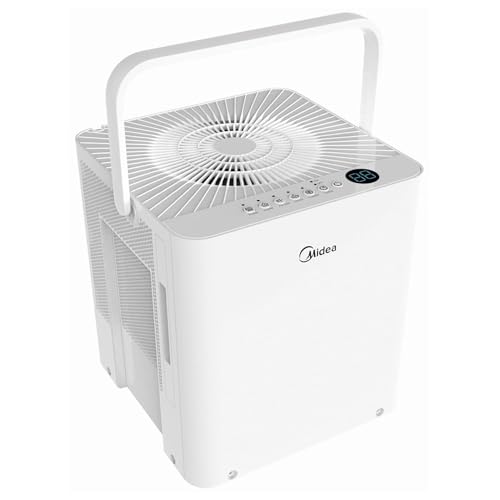Are you finding your home gym uncomfortably humid and stifling? You may be contemplating whether a dehumidifier could be the solution to cooling your workout environment.
While a dehumidifier doesn’t directly lower the temperature like an air conditioner, it does work to balance the relative humidity, making the air feel less muggy and more comfortable. This can result in a perceived sense of coolness, even without a decrease in the actual temperature.
If you’re fed up with excessive sweating during your home gym sessions, you’re in the right place. In this article, we’ll explore the advantages of using a dehumidifier in your home gym and much more.
Ready to transform your workout experience? Let’s get started!
Understanding Dehumidifiers
How Dehumidifiers Work
Dehumidifiers help maintain a comfortable indoor environment by removing excess moisture from the air.
The basic function of a dehumidifier is to take in humid air, extract the moisture, and then release dry air back into your living space.
Two primary components help it achieve this: the compressor and the desiccant.
In a refrigerant dehumidifier, the compressor cools metal coils, and as the warm, humid air passes over these coils, the moisture in the air condenses into water droplets.
These droplets then collect in a container or are pumped out of the dehumidifier, and the dryer air is now circulated back into your room.
A desiccant dehumidifier, on the other hand, uses a moisture-absorbing material called a desiccant.
The humid air is drawn through the desiccant, which captures the moisture and releases drier air.
Desiccant dehumidifiers may also have a heating element to help dry out the absorbed moisture.
Types of Dehumidifiers
Depending on your needs, you can choose two main types of dehumidifiers: desiccant dehumidifiers and refrigerant dehumidifiers.
- Desiccant Dehumidifiers: These units are ideal for use in colder rooms, as they can efficiently lower humidity levels even in low temperatures. They are quieter than their refrigerant counterparts and can be more energy-efficient in colder climates. However, they may struggle with higher humidity levels and are often better suited for smaller spaces.
- Refrigerant Dehumidifiers: These are the most common type of dehumidifiers found in homes, often used in basements, laundry rooms, or garages. They are more effective at reducing high humidity than desiccant dehumidifiers, but they tend to consume more energy and can be less efficient in colder temperatures.
It’s essential to choose the right type of dehumidifier for your specific needs, taking into account your room size, humidity levels, and the climate in which you live.
Selecting an appropriate dehumidifier can help you maintain a comfortable workout space, offering relief from mold, mildew, and other issues caused by excessive humidity.
Does a Dehumidifier Cool a Room
The Effect on Temperature
When it comes to whether a dehumidifier can cool a room, the answer is not straightforward.
Technically, a dehumidifier does not cool a room like an air conditioning unit. Instead, a dehumidifier works by removing excess moisture from the air, lowering the room’s humidity levels.
This can create a sensation of coolness, even though the actual temperature may not change significantly.
It’s important to note that dehumidifiers can actually increase the ambient temperature by a few degrees. This is because they are electrical appliances that generate heat as they operate.
However, the overall impact on comfort may still be positive, as we’ll see in the next section.
The Impact on Comfort
While a dehumidifier might not have a significant effect on the actual temperature of a room, it can greatly improve comfort levels.
As the device reduces humidity, it makes the air feel less sticky and damp. This can make the room feel more comfortable, even without a major temperature change.
In fact, lower humidity levels can make the air feel cooler than it is, making the overall atmosphere more pleasant.
Moreover, by removing moisture from the air, a dehumidifier can help your air conditioner work more efficiently.
Since air conditioners work by evaporating and condensing moisture to cool the air, the presence of excess humidity can strain the air conditioner and make it less effective.
By removing some of this moisture, a dehumidifier can help your air conditioner cool the room more quickly, which may save energy in the long run.
Benefits of Using a Dehumidifier
Improving Air Quality
Using a dehumidifier in your home gym can have a significant impact on improving air quality.
By reducing humidity levels, you make it more difficult for mold and mildew to grow, which in turn creates a healthier workout environment for you and your family.
When humidity levels are too high, it can cause excessive moisture in your home, leading to musty smells and even mold and mildew growth.
By lowering the humidity levels with a dehumidifier, you’ll create a more comfortable environment for yourself and protect your home and belongings from the damaging effects of excess moisture.
Reducing Allergies and Respiratory Issues
If you suffer from allergies or respiratory problems, using a dehumidifier might be beneficial for you.
High humidity levels can promote the growth of allergens like mold and dust mites, leading to increased allergy symptoms and worsening respiratory issues.
A dehumidifier works by drawing in warm, damp air and removing excess moisture before releasing it back into the room. As a result, this helps reduce the concentration of allergens in the air, improving air quality and potentially alleviating allergy and respiratory symptoms you might experience.
Remember, while a dehumidifier can certainly help with allergies and respiratory issues, it doesn’t replace proper cleaning and air filtration practices. Regularly cleaning your home and using air purifiers with HEPA filters can further enhance your air quality and overall health.
Considerations for Dehumidifier Usage
Choosing the Right Size and Type
When selecting a dehumidifier, it’s essential to consider the humidity levels and the size of the space you want to use it in. You can determine the right size dehumidifier by the square footage of your room.
There are different types of dehumidifiers, such as condenser-based and silica-gel models. Make sure to research their unique features and select one that meets your needs.
Monitoring your room’s humidity levels with a hygrometer can help you decide on the appropriate device.
Placement and Space Requirements
The placement of your dehumidifier plays a critical role in its effectiveness.
Position it with enough space on all sides to ensure proper airflow. Avoid placing it in areas with direct sunlight or extreme temperatures, which can affect the device’s performance.
Make sure to empty the tank regularly to prevent overflow and maintain efficiency. Some dehumidifiers have an automatic shut-off feature, which turns off the device when the tank is full.
Energy Consumption and Efficiency
Energy consumption is another crucial factor to consider. Dehumidifiers with a larger capacity will generally consume more energy, but they may also provide a more noticeable cooling effect due to their ability to remove more humid air.
Choose a device with an energy-efficient rating to save on your energy bills. Remember, a dehumidifier works best at maintaining a specific humidity level, so constantly running it may lead to higher energy consumption.
Properly calibrating your device to the ambient temperature and desired humidity level will optimize its performance and energy efficiency.
Can you dehumidify a room too much?
Yes, you can dehumidify a room too much. Maintaining the right humidity level is essential for your comfort and the overall health of your living space. Over-dehumidifying a room can lead to some unwanted consequences.
When you use a dehumidifier, keeping tabs on your humidity levels is essential. You can do this with a hygrometer, which measures the moisture content in the air.
If you notice your humidity levels are very low, you should take steps to rectify the situation quickly to avoid potential issues.
Over-dehumidifying can cause several problems, such as:
- Dry skin and eyes: Excessively low humidity levels can lead to dry, itchy skin and irritated eyes, similar to allergy symptoms.
- Damage to wooden furniture and floors: When the humidity level is too low, wood can dry out and become more prone to cracks.
To ensure your home maintains a healthy humidity level, try to keep it between 30% and 50%. Within this range, you should feel comfortable, and your home should be protected from any potential problems related to excess moisture or dryness.
If your dehumidifier has a built-in humidistat, this task can be more straightforward, as the device will automatically adjust its operation to maintain the desired humidity level.
Alternatives and Complementary Solutions
Are Dehumidifiers An Alternative to Air Conditioning?
Dehumidifiers are not technically designed to cool a room, but they can help make the atmosphere more breathable by reducing humidity levels.
While air conditioning units are specifically designed to lower room temperature, dehumidifiers focus on removing excess moisture, which can make the environment feel cooler and more comfortable. source
Air Conditioning Units and Fans
Air conditioning units remove heat and humidity from the air through refrigeration, making your space more comfortable.
They use an evaporator and condenser coil to heat exchange, cool the air, and lower room temperature.
Fans can also be a cost-effective and energy-efficient option for smaller spaces to maintain a comfortable atmosphere.
Proper Ventilation
Ensuring your space is well-ventilated can greatly reduce the need for air conditioning.
Opening windows and doors during cooler hours, using exhaust fans in the kitchen and bathroom to remove hot air, and installing vents or air purifiers can help improve air circulation and reduce humidity sources.
Good ventilation can also help prevent mold growth and alleviate asthma symptoms caused by poor air quality.
Managing Humidity Sources
There are several ways you can manage humidity sources in your home:
- Water sources: Make sure to promptly fix any water leaks and avoid activities that release large amounts of moisture into the air, such as taking long, hot showers.
- Outdoor humidity: Keep windows and doors closed during times of high outdoor humidity to prevent it from entering your home.
- Plants: Be mindful of the number of plants in your home, as they can release moisture into the air through transpiration.
- Appliances: Use appliances that produce heat and humidity, like ovens and dishwashers, during cooler hours of the day.
By managing your home’s humidity levels and employing a combination of dehumidifiers, air conditioning units, fans, and proper ventilation, you can maintain a comfortable atmosphere, reduce mold and mildew growth, and enjoy a healthier living environment.
Best Dehumidifiers for Your Garage Gym
The Levoit Humidifier is a versatile, high-quality dehumidifier that efficiently removes excess moisture from your home gym.
It’s designed to provide comfortable humidity levels for spaces up to 4500 square feet, making it suitable for large garage gyms.
Pros:
- Effective at maintaining optimal humidity levels
- Covers up to 4500 square feet
- Quiet operation, perfect for garage gyms
Cons:
- Slightly on the larger side
- It can be a bit expensive
We earn a commission if you make a purchase, at no additional cost to you.
The Midea Dehumidifier is an affordable but powerful option for maintaining a healthy humidity level during gym sessions in your garage gym.
It has a 50-pint capacity and is ideal for removing moisture in spaces up to 3000 square feet.
Its built-in pump efficiently drains the water, allowing you to focus on your workouts without worrying about emptying the tank.
Pros:
- Affordable and great value for money
- Covers up to 3000 square feet
- Built-in pump for easy water drainage
Cons:
- Less coverage compared to Levoit Humidifier
- Noisier operation
Conclusion
Adding a dehumidifier to your home gym can significantly enhance your comfort and well-being, particularly during humid seasons.
While it’s crucial to remember that a dehumidifier doesn’t directly cool the air, it does play a vital role in making your workout space feel more comfortable by reducing humidity levels.
So, why not give a dehumidifier a try? Experience the refreshing and invigorating environment it can create for you and your loved ones.








